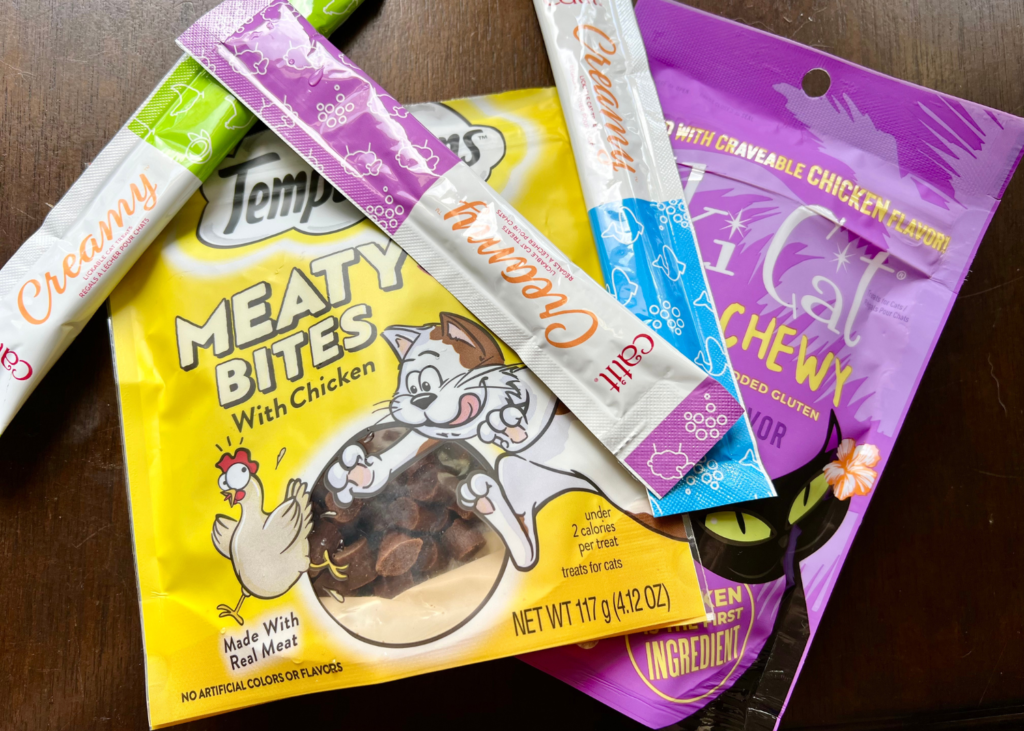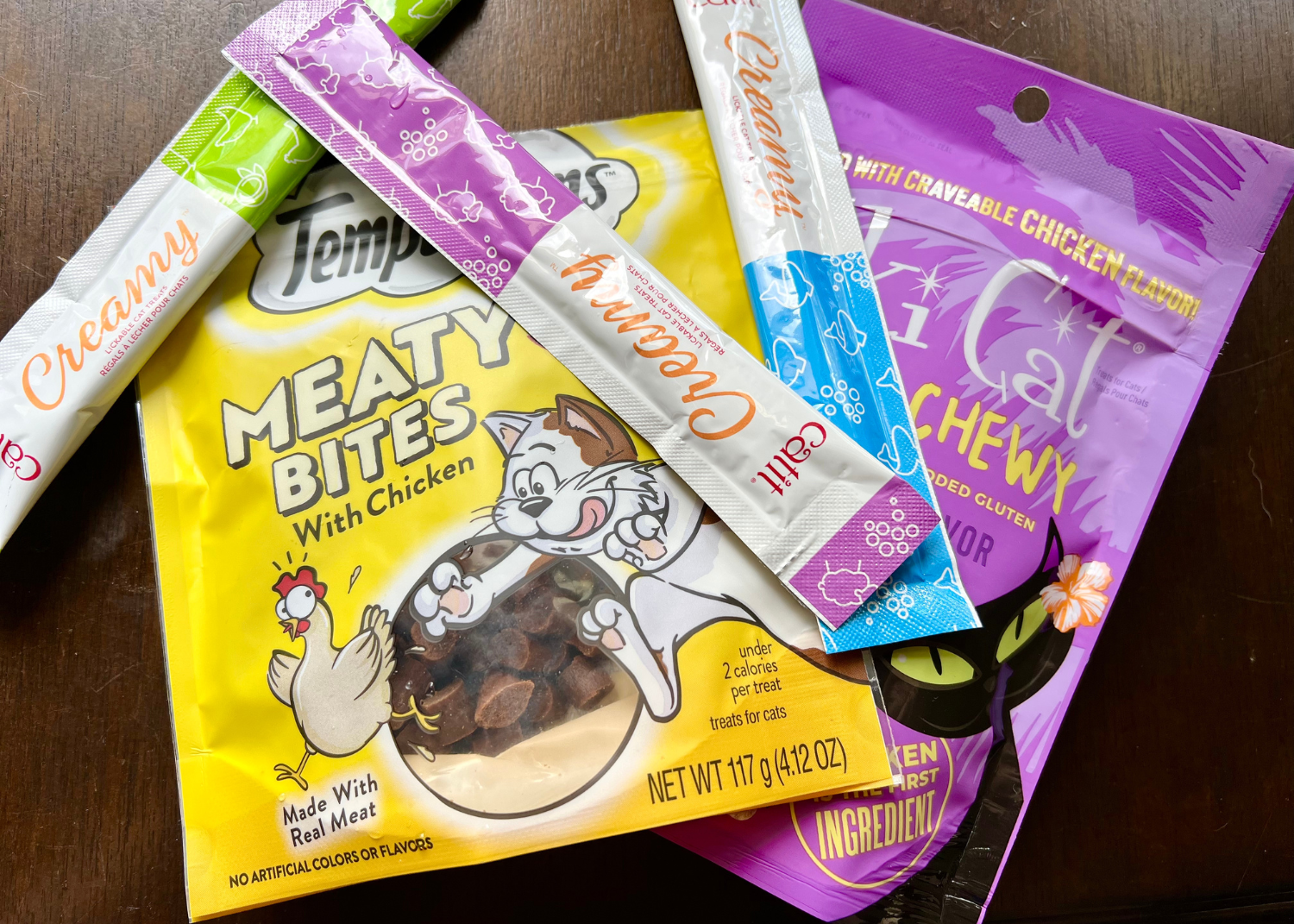What are the Best Treats for Clicker Training Cats?
Every Cat School student wants to know which food reward is best for clicker training their cat. The answer is: there isn’t one.
At any given time, if you look inside my treat pouch, you will see a variety of treats. The food I use to teach my cat tricks is different from the treats I use to help him accept nail trims. The reward that I use indoors in a quiet room is different than the one I use outdoors when there are multiple distractions.
How will you know which food reward to use for a given situation? Start by understanding that there are high-value and low-value treats so that you can use them strategically.
Each cat will have their preferences for rewards. Generally speaking, your cat’s preferences will depend mainly on what you feed them for meals. If you are feeding your cat a processed food diet, it will be tough to find a reward that can compete — that’s like feeding a child french fries and then offering a granola bar for dessert. “More french fries, please.”

Disclosure: Cat School may receive commissions from affiliate links included in this article.
It’s not about finding the best treats for your cat. It’s about feeding the best meals.
If we want our cats to accept a variety of rewards, we have to start by feeding them healthy, moisture-rich meals. It doesn’t matter if it’s organic or grain-free — dry food is not suitable as a cat’s main meal. Cats need to get moisture from their diet.
Manufacturers of dry food fight to get a monopoly on your cat’s taste buds. They formulate a coating on dry food to turn your cat into a “kibble addict,” and your “picky” cat becomes their customer for life.
When people reach out to tell me that their cat doesn’t like any treats, I can usually tell what’s going on — the cat is on a dry food diet with their food left out all day.
If you leave a bowl of dry food out for your cat to pick at throughout the day, you will decrease their food motivation and make it challenging to find training rewards.
Imagine having a money tree in your backyard where you can collect a twenty-dollar bill whenever you need one. As soon as you grab that twenty, the tree grows another one. With an endless supply of money, would you be motivated to go to work? Probably not.
To build a cat’s food motivation, we need to stop making their food readily available and switch to feeding small, scheduled meals – at least three small meals per day. If you are out for long hours, consider getting an automatic feeder for wet food. We also need to make sure cats eat a healthy moisture-rich diet. Once you make these adjustments, you should start to see an improvement in your cat’s food motivation, and it should be easier to find food rewards for clicker training.

My Favorite Treats
When I select treats for training cats, I look at several variables:
- Treats should be healthy: I stay away from processed treats and stick to something with just one or a few natural ingredients.
- Treats should be tiny: Small rewards will help the cat stay motivated while preventing weight gain. If your cat is spending time crunching on large treats, it will slow down your training.
- Dry treats are easier for training: Although you can train with wet treats, I prefer to use dry food pieces. Working with dry food is easier, and you can toss treats away to increase activity.
What treats meet these criteria? For indoor training, freeze-dried treats like these are my favourite. Freeze-dried treats are healthy, dry, and you can break them into tiny pieces. Freeze-dried treats also come in different flavours (proteins).
One challenge of freeze-dried treats is that they can be quite expensive. To cut the costs, you can purchase freeze-dried cat food and break those into tiny pieces. In the meal section for cats, there is often freeze-dried food labelled “topper” that goes on top of your cat’s meal to stimulate their appetite or give them healthier food. To save money, I buy a bag of the topper and use those as training rewards.
Another advantage of freeze-dried treats is that they are easy to introduce to your cat. Most cats like them, but if they are suspicious at first, try crumbling a tiny bit over their wet food.
Freeze-dried treats are perfect for most of the training I do with my cat, Jones, but when I’m working on harder behaviours, such as nail trims, vet visits, and training sessions outside amongst many distractions, I raise the bar on the tasty treats. In these situations, I worry less about health and bring out the highest value rewards. For Jones, that is usually a lickable treat like Inaba Churu Purée and Temptations. I use these treats sparingly, but they are perfect for keeping Jones motivated in challenging training scenarios.
Where Do I Start?
Focus on upgrading your cat’s meals first. Implement a feeding schedule and introduce your cat to a moisture-rich diet. Once you’ve upgraded your cat’s meals, you can use a handful of the dry food for training. Introduce some freeze-dried treats and see how your cat does.
I recommend you reserve lickable treats, like Inaba Churu puree and more processed treats, like Greenies and Temptations for the hardest behaviours.

Churu Purée Treats are excellent for working on nail trims and other grooming and handling skills.
Remember, it’s not about the treats — small, scheduled moisture-rich meals are the secret to having a cat that will work for rewards.
Get Help
Many students will need extra help with building their cat’s food motivation. When you join our online membership you will find a comprehensive section on overcoming food challenges. You can also post for help and read our forum of other student’s experiences. While food challenges can be hard to overcome, it is well worth it to start this journey. The result is a happier, healthier cat that benefits from the enrichment of clicker training.

